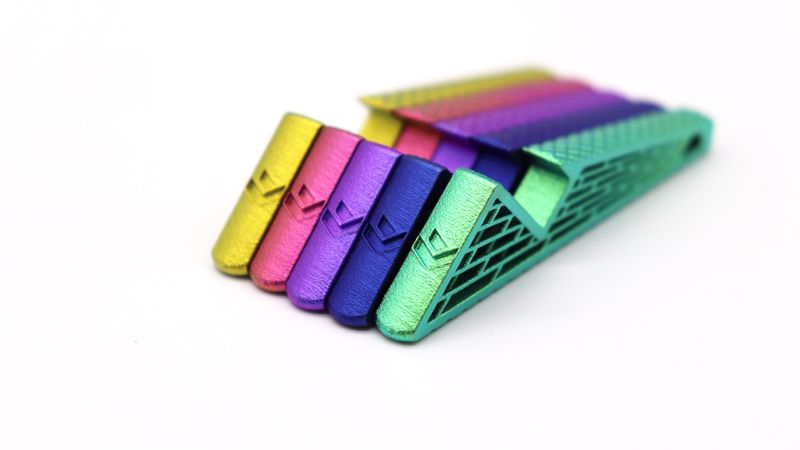Enhancing Metal 3D Printed Parts: Finishing Technologies and Techniques
Metal 3D printing enables the creation of complex and precise components directly from digital designs. To achieve desired aesthetic and functional qualities, the printed parts sometimes require finishing processes.

Metal 3D printed Titanium bottle openers - anodized
Finishing techniques can enhance the surface quality, durability, and appearance of metal 3D printed parts, making them suitable for a wide range of applications. Here’s a look at some of the key finishing technologies used in metal additive manufacturing.
Air Blasting
Air blasting is a versatile finishing process that involves accelerating blasting materials through a nozzle to treat the surface of a metal part. This technique is commonly used to clean surfaces, remove residual powder from the 3D printing process, and alter surface roughness. By reshaping or removing material, compressed air blasting can enhance the texture of a part, making it smoother or more consistent. It is particularly useful for preparing parts for further finishing processes or improving their mechanical properties.
Blackening
Blackening is a specialized finishing technique primarily used on iron and steel components. The process involves creating a thin protective layer of black oxide on the surface of the metal, which helps to reduce rust and improve friction properties. Blackening not only enhances the aesthetic appeal of a part by giving it a darker, matte finish but also preserves its dimensions, making it a popular choice for parts that require both protection and precision. This technique is commonly used in firearms, tools, and other iron-based products.
Gold plating
Gold plating is the process of covering a metal surface with a layer of gold through electroplating. In this technique, the metal object is submerged in a gold electrolyte solution, and an electric current is applied to deposit a thin, uniform layer of gold onto the surface. Gilding is often used for decorative purposes, adding a luxurious appearance to metal parts. Additionally, it can provide a layer of corrosion resistance, making it a practical as well as an aesthetically pleasing finish for high-end applications.
Anodizing
Anodizing is a finishing process that creates a protective oxide layer on metal surfaces by converting the existing material rather than adding an external layer. This process involves submerging the part in an electrolyte solution and applying an electric current, which forms a thin, compact oxide layer on the surface. The thickness of this layer can be varied, resulting in different colors, from deep blacks to vibrant blues and reds. Anodizing is commonly used on aluminum parts to enhance corrosion resistance, improve wear resistance, and achieve a decorative finish.
Nickel Plating
Nickel plating involves applying a layer of pure nickel to a metal surface using electric currents. This process is widely used to protect metals such as iron and steel from corrosion while also enhancing their appearance. Nickel plating can be applied in varying thicknesses, making it suitable for both decorative applications and industrial uses where a durable, corrosion-resistant coating is needed. It is also commonly used as a base layer for other finishes or to improve solderability in electronic components.
Polishing
Polishing is a finishing process that smooths and refines the surface of a metal part through mechanical grinding and the application of polishing compounds. This process can remove material, round sharp edges, and fill in surface pores, resulting in a smooth, glossy finish that reflects light evenly. Polishing is often used to reduce friction on mechanical parts, enhance their aesthetic appeal, and prepare surfaces for further treatments such as plating or coating. It is an essential step in achieving a high-quality finish on metal 3D printed parts.
The finishing processes available for metal 3D printed parts offer a wide range of enhancements, from improved durability and corrosion resistance to aesthetic improvements and precise surface alterations. By selecting the appropriate finishing technique, manufacturers can ensure that their metal 3D printed parts meet the highest standards of quality and functionality, suitable for both industrial and consumer applications.